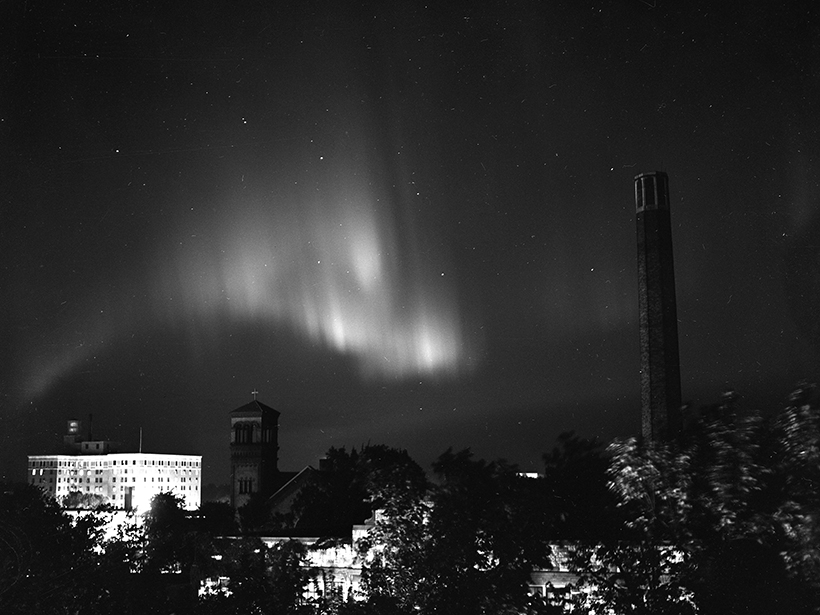Seventy-five years ago, on 18–19 September 1941, the Earth experienced a great magnetic storm, one of the most intense ever recorded. It arrived at a poignant moment in history, when radio and electrical technology was emerging as a central part of daily life and when much of the world was embroiled in World War II, which the United States had not yet officially entered.
The illuminated night sky exposed an Allied convoy to German attack.
Auroras danced across the night sky as voltage surged in power grid lines. A radio blackout interrupted fan enjoyment of a baseball game, while another radio program was interrupted by private phone conversations. Citizens, already on edge, wondered if neon lights were some sort of antiaircraft signal. And far away in the North Atlantic, the illuminated night sky exposed an Allied convoy to German attack.
These effects raised awareness within the scientific community and among the public of the societal significance of the effects that the Sun and outer space can have on the Earth—what we now call space weather.
Solar-Terrestrial Interaction
On 10 September 1941, during the declining phase of solar cycle 17, astronomers saw an unusually large, low-latitude group of sunspots on the eastern limb of the Sun. The spots had formed, as they all do, with the buoyant emergence of a concentrated bundle of magnetic field lines from the Sun’s interior through the photosphere. Over the course of the next week the spots grew, and the Sun’s rotation brought them near the center of the solar disk as viewed from Earth [e.g., Richardson, 1941]. The sunspot group was large enough to be seen with the naked eye.
At 08:38 universal time (UT) on 17 September 1941, the Greenwich Observatory spectrohelioscope recorded a solar flare above this sunspot group [Newton, 1941]. The emitted ultraviolet and X-ray radiation abruptly enhanced the ionization of the Earth’s atmosphere, causing a sharp perturbation known as a “crochet” in dayside ground-based recordings of the geomagnetic field and temporarily interfering with high-frequency radio communication. Subsequently, scientists at the Mount Wilson Observatory in California observed another solar flare at 16:26 UT [Richardson, 1941].
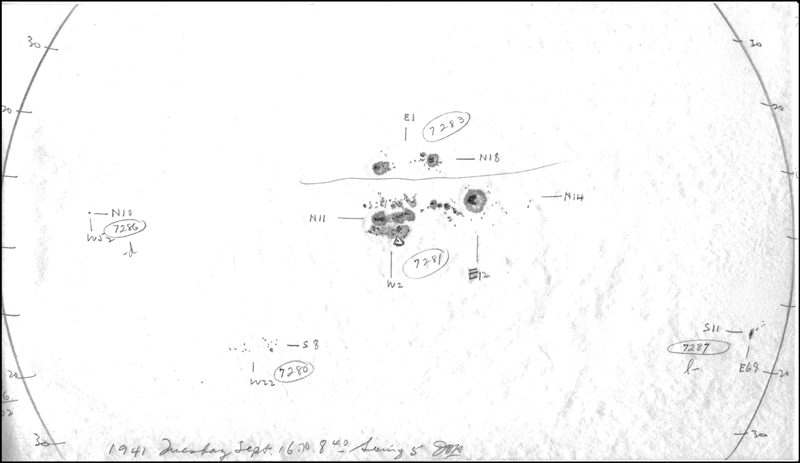
On the basis of daily sunspot reports supplied by the U.S. Naval Observatory, the Department of Terrestrial Magnetism at the Carnegie Institution of Washington formally issued a warning to radio operators that they could expect significant disturbances to ionospheric and geomagnetic conditions beginning on about 18 September [McNish, 1941a]. This prediction, which turned out to be accurate, is a noteworthy development in the historical development of methods for reliably forecasting space weather.
Less than 20 hours after the flare was reported by Greenwich, a magnetic storm commenced at 0412 UT on 18 September with the arrival at Earth of a coronal mass ejection. This mass ejection abruptly compressed the magnetopause and generated a magnetic impulse that was recorded by observatories around the world [Newton, 1941]. The magnetic superstorm that followed was complex, intense, and of long duration.
A magnetic observatory in Cheltenham, Md., operated by the U.S. Coast and Geodetic Survey, registered six separate occurrences of geomagnetic storms with a K index of 9 (the most intense value possible). Five of these occurred consecutively over a 24-hour period. In terms of a related global index , the level of geomagnetic activity over a 24-hour period has not since been matched [e.g., Cliver and Svalgaard, 2004].
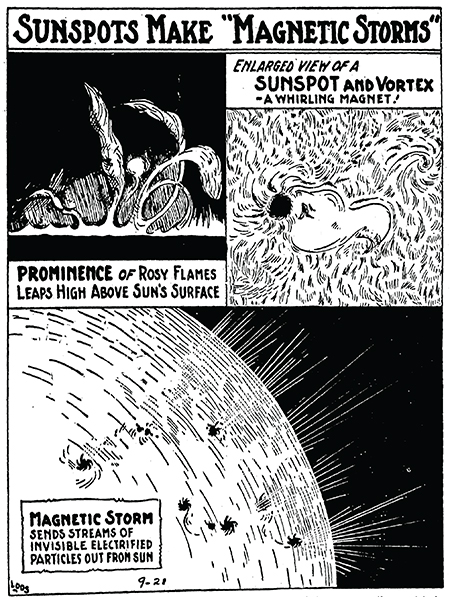
An Auroral Light Show
On 18–19 September 1941, the Moon was nearly new, ideal for seeing the auroral light that the magnetic storm produced in many nighttime skies. The observer in charge at the Cheltenham, Md., observatory [Ludy, 1941] reported a brilliant auroral display of rays and moving drapery of pink, green, and lavender. He also described an auroral corona, where light appears to stream down from directly overhead, a phenomenon rarely seen at midcontinental latitudes.
Weather Service observers reported seeing auroras in New Mexico [Cameron, 1941]. Letters to Sky and Telescope [1941] described the auroras seen around the United States. One amateur astronomer from Rhode Island [Boss, 1941] wrote a detailed description of the “celestial pyrotechnics,” and he apparently stayed up all night watching the spectacle, until the paperboy delivered the morning newspaper with the headline “Auroral Display Watched by Thousands.”
The popular press provided vivid accounts of the auroras. The Brooklyn Eagle [1941] described celestial “neon lights.” The Chicago Tribune [1941a] reported that a “cosmic brush painted the Chicago sky with light” and that motorists parked on the highways had caused a traffic jam as they sought a clear view of the celestial spectacle.
According to the Washington Post [1941a], some people wondered if the celestial events had something to do with national defense: “Was it an antiaircraft search battery?” These were, after all, difficult times. The United States was already being drawn into World War II [e.g., Heinrichs, 1988], and many citizens anticipated even greater involvement.
“Was it an antiaircraft search battery?”
Auroras were also seen in Europe, but not surprisingly, most newspaper articles focused on wartime events. Newspapers, for example, succinctly reported that the British Royal Air Force carried out a raid on a German supply base on the Baltic Sea [Washington Post, 1941b] and that the Germans bombarded Leningrad [Chicago Tribune, 1941b], each under the lights of the aurora borealis.
When the magnetic storm finally subsided and the aurora faded, a New York Times [1941c] article described the events, in war terms that were common at the time, as an “ethereal blitz.” Some readers even optimistically saw the auroral displays as a representation of hope for victory [New York Times, 1941d].
Electric Power System Disruptions
Storm time geomagnetic activity can induce geoelectric fields in the Earth’s electrically conducting crust and lithosphere of sufficient strength to interfere with the operation of electric power grids.
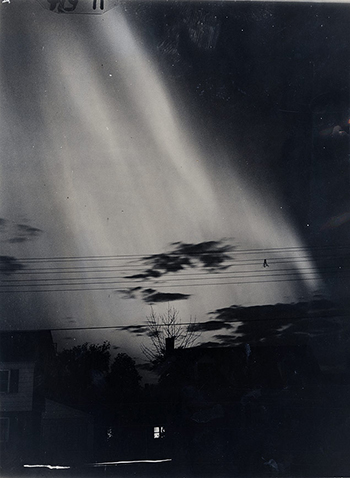
Magnetic activity recorded at the Cheltenham, Md., observatory abruptly increased at about 19:45 UT on 18 September [Fleming, 1943, p. 204]. Almost simultaneously, at 19:45 and 19:50 UT, the Pennsylvania Water and Power Company recorded uncontrolled voltage variations in transmission lines connecting generating plants on the Susquehanna River with Baltimore and Washington. At the moment when the auroral brilliance was greatest, system transformers vibrated and groaned as a result of geomagnetically induced currents [McNish, 1941b].
Radio Silence and Spice
The National Bureau of Standards [1941] reported a great ionospheric disturbance starting at about 06:00 UT on 18 September, 2 hours after the sudden commencement of the magnetic storm. We might retrospectively infer that this was caused by substorm precipitation of charged particles into the Earth’s auroral zone. This would have disrupted over-the-horizon radio signals that are normally calibrated for a set level of ionospheric reflectivity.
And, sure enough, as a result of the 18–19 September storm, widespread interference was reported for radio transmissions around the world [e.g., General Electric, 1941; Conklin, 1941]. As part of these developments, two amusing happenings were reported in the New York Times [1941a, 1941b], Newsweek [1941], and Time [1941], paraphrased here.
First, on the afternoon of 18 September, the Pittsburgh Pirates hosted the Brooklyn Dodgers in a game of baseball. Red Barber, a well-known sports commentator, was calling the game for WOR Radio. In the fourth inning, with the score tied at 0–0, the broadcast lost signal for 15 minutes. By the time the broadcast resumed, the Pirates had 4 accumulated runs. Irate Brooklyn fans phoned the radio station to complain, but they found “little satisfaction” with the “explanation that the sun,” sunspots, and the related magnetic storm were to blame for the outage. To top it off, the Dodgers went on to lose to the Pirates, 5-6.
A phone conversation between two men discussing their previous night’s amours could be heard in background.
The next morning, radio station WAAT was broadcasting a program of Bing Crosby songs. Suddenly, during “Where the Blue of the Night (Meets the Gold of the Day),” a phone conversation between two men discussing their previous night’s amours could be heard in background. Workers at the radio station tried without success to clear up what was apparently some sort of silly mix-up of signals. Station representatives later claimed that although the conversation was “strong,” it was also “not particularly objectionable.”
When the men’s phone conversation did finally fade, it was replaced by what was described in the language of the time a “spicy” conversation between two young women talking about a blind date: “I fixed it for Eddie to pick up a guy for you.” Before station operators could mute the conversation, the colorful “crosstalk had faded, and decorum was again supreme” on the airwaves. Communications engineers for the Radio Corporation of America attributed the trouble to sunspots and the magnetic storm.
Wartime Event in the Atlantic
Far away from those innocent events in the United States, in the frigid North Atlantic Ocean east of southern Greenland, several German U-boats of the Brandenburg wolf pack were lurking. They operated there, out of reach of Iceland-based Royal Air Force maritime patrols, in search of eastbound ships that were keeping Britain supplied during the war.
Kapitänleutnant Eitel-Friedrich Kentrat of U-74 recorded the ensuing events in his war diary [Morgan and Taylor, 2011, pp. 119–123]: “September 18, 1941, visibility 4–6 nautical miles, a number of smoke plumes on the horizon, vessels seem well strung out.” Kentrat had spotted SC-44, a Canadian convoy of cargo ships. For protection, a destroyer and small antisubmarine warships known as corvettes escorted SC-44 along its journey.
A wartime convoy would normally have been relatively securely hidden in the dark of night. But not this night.
At 22:30 UT, Kentrat issued a radio dispatch to headquarters and the other Brandenburg U-boats, “Alpha. Alpha. Enemy convoy in sight. Quadrant AD9761. Course NE, moderate speed. U-74.” Unsure whether his compatriots received his message, he recorded in his diary that since 04:30 UT on 18 September, “short-wave radio reception has been very poor and it gradually cuts out altogether. We try absolutely everything but without success. I hope the other Brandenburg boats can receive me.” Unbeknownst to Kentrat, his radio problems were caused by the magnetic storm and the ionospheric disturbance that followed.
As the Sun set, the sea haze lifted. Under such conditions, a wartime convoy would normally have been relatively securely hidden in the dark of night. But not this night. The sky was ablaze with the aurora borealis. Kentrat described the conditions as being “as bright as day.” Ironically, in a postwar interview [Johnston, 2008, p. 38], a crewman on board a ship in the convoy, the SC44 corvette HMCS Lévis, recalled seeing the aurora on that evening and remarking to a fellow crewman, “What a night for a torpedoing.” This bit of dark humor would turn out to be prophetic.
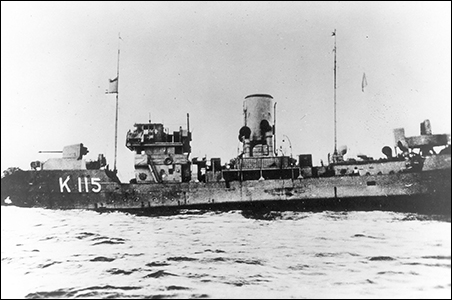
At 01:00 UT on 19 September, Kentrat tried several times to maneuver U-74 into attack position on the starboard side of the convoy, only to be “driven off” each time by SC-44’s defending corvettes. They didn’t pursue for long, but Kentrat became concerned that his own U-boat was too visible “in these conditions.” (In those days, submarines were only occasionally submerged.) He decided to maneuver “to the port side of the convoy, where the Northern Lights [were] less bright.”
At 03:50 UT, Kentrat radioed, “Brandenburg boats report in immediately.” (He did not know at the time that the other U-boats had been receiving his radio messages; he just hadn’t been receiving theirs.) At 05:03 UT, from the unusually long distance of 3 kilometers, Kentrat ordered four torpedoes fired in spread formation at the convoy. Afterward, U-74 quickly turned around to escape, and Kentrat ordered a fifth torpedo fired from the stern. Monitoring the results through his periscope, Kentrat reported a direct hit, “a plume” and “green light.” A torpedo had struck the stern of the Lévis, nearly cutting her in two. Afterward, Kentrat recorded detecting a desperate Morse code signal: “help.”
Hours later, the Lévis sank. Of the ship’s complement, 18 died and 40 were rescued.
Modern Implications
Although the magnetic storm of 18–19 September was of only minor anecdotal consequence compared to the terrible and momentous events of World War II, its occurrence does provide us with an opportunity to reflect on the course of history and how things have and have not changed. During the war, some geophysical and astronomical observatories were temporarily closed, but others managed, sometimes against considerable challenge, to remain open and operational. The data collected during this time from war zone observatories are a lasting testament to the dedication of their workers.
Zooming ahead to today, we are more dependent than ever on modern technology. For this reason, the plausible future occurrence of a space weather superstorm could have widespread impact—disrupting over-the-horizon radio communication, degrading the accuracy of global positioning systems, damaging satellite electronics and increasing their orbital drag, interfering with geophysical surveys, exposing airplane pilots and passengers to unhealthy radiation levels, and even interrupting electric power distribution for prolonged periods [e.g., Baker et al., 2008; Cannon et al., 2013]. Strategic planning [e.g., National Science and Technology Council, 2015] is helping focus resources in support of research, monitoring, assessment, prediction, mitigation, and response planning related to extreme space weather events.
Acknowledgments
We thank C. A. Finn, S. J. Hardy, J. McCarthy, E. J. Rigler, and J. L. Slate for reading a draft manuscript. We thank E. W. Cliver, W. F. Denig, and H. J. Singer for useful conversations. Part of this work was accomplished while J.J.L. was a visiting professor at the Université Paris Diderot in September 2015. This is IPGP contribution 3760.
References
Baker, D. N., et al. (2008), Severe Space Weather Events—Understanding Societal and Economic Impacts, 144 pp., Natl. Acad. Press, Washington, D. C.
Boss, L. J. (1941), Notes from amateurs: The aurora of September 18–19, 1941, Pop. Astron., 49(11), 504–505.
Brooklyn Eagle (1941), Celestial “neon lights” cut news from Europe, p. 3, 19 Sept.
Cameron, D. C. (1941), Climatological data, New Mexico section, Climatol. Data, N. M. Sect., 45(9), 65.
Cannon, P., et al. (2013), Extreme Space Weather: Impacts on Engineered Systems and Infrastructure, 68 pp., R. Acad. Eng., London.
Chicago Tribune (1941a), Cosmic brush paints Chicago sky with light, part 1, p. 1, 19 Sept.
Chicago Tribune (1941b), Northern lights add eerie glare to war in Arctic, part 1, p. 5, 21 Sept.
Cliver, E. W., and L. Svalgaard (2004), The 1859 solar-terrestrial disturbance and the current limits of extreme space weather activity, Sol. Phys., 224(1), 407–422, doi:10.1007/s11207-005-4980-z.
Conklin, J. (1941), UHF…The big aurora, Radio, 263, November, 55.
Fleming, J. A. (1943), The Sun and the Earth’s magnetic field, in Annual Report of the Smithsonian Institution, 1942, pp. 173–208, U.S. Gov. Print. Off., Washington, D. C.
General Electric Review (1941), Dodging the aurora: High lights and side lights, 44(10), 573.
Heinrichs, W. (1988), Threshold of War: Franklin D. Roosevelt and American Entry into World War II, 302 pp., Oxford Univ. Press, New York.
Johnston, M. (2008), Corvettes Canada: Convoy Veterans of World War II Tell Their True Stories, 272 pp., John Wiley, Mississauga, Ont., Canada.
Ludy, A. K. (1941), Cheltenham magnetic observatory, July to September 1941, Terr. Magn. Atmos. Electr., 46(4), 474, doi:10.1029/TE046i004p00474.
McNish, A. G. (1941a), The great geomagnetic storm of September 18–19, 1941, Sci. Mon., 53(5), 478–481.
McNish, A. G. (1941b), The aurora and geomagnetic storm of September 18–19, 1941, Terr. Magn. Atmos. Electr., 46(4), 461–463, doi:10.1029/TE046i004p00461.
Morgan, D., and B. Taylor (2011), U-Boat Attack Logs: A Complete Record of Warship Sinkings from Original Sources, 1939–1945, 480 pp., Seaforth, Barnsley, U. K.
National Bureau of Standards (1941), High-frequency radio transmission conditions, September, 1941, with predictions for December, 1941, Proc. Inst. Radio Eng., 29(10), 563–564.
National Science and Technology Council (2015), National space weather strategy, 14 pp., White House Off. of Sci. and Technol. Policy, Washington, D. C.
Newsweek (1941), Aurora sideshow, 18(13), 18.
Newton, H. W. (1941), The great spot group and magnetic storm of September 1941, Observatory, 64, 161–165.
New York Times (1941a), Aurora borealis gives city a show as sun spots disorganize radio, p. 25, 19 Sept.
New York Times (1941b), Sun spots add some radio spice, sneaking private phone calls on air, p. 19, 20 Sept.
New York Times (1941c), Short wave better as ‘storm’ abates: Magnetic disturbance fades—Another ‘blitz’ feared, p. 46, 21 Sept.
New York Times (1941d), Aurora borealis: Victory sign, Mail-bag excerpts, p. 113, 28 Sept.
Richardson, R. S. (1941), The sunspot-group associated with the magnetic storm of September 18, 1941, Terr. Magn. Atmos. Electr., 46(4), 459–460, doi:10.1029/TE046i004p00459.
Sky and Telescope (1941), Letters, 1(1), 14–15.
Time (1941), Magnetic uproar, 38(13), 59.
Washington Post (1941a), Northern light show visits South, p. 1, 19 Sept.
Washington Post (1941b), Nazi cities hit as northern lights illumine raiders’ goals, p. 1, 21 Sept.
Author Information
Jeffrey J. Love, Geomagnetism Program, U.S. Geological Survey, Denver, Colo.; email: [email protected]; and Pierdavide Coïsson, Institut de Physique du Globe de Paris, Sorbonne Paris Cité, Paris, France; and Université Paris Diderot, Centre National de la Recherche Scientifique, Paris, France
Citation:
Love, J. J.,Coïsson, P. (2016), The geomagnetic blitz of September 1941, Eos, 97, https://doi.org/10.1029/2016EO059319. Published on 15 September 2016.
Text © 2016. The authors. CC BY-NC-ND 3.0
Except where otherwise noted, images are subject to copyright. Any reuse without express permission from the copyright owner is prohibited.

